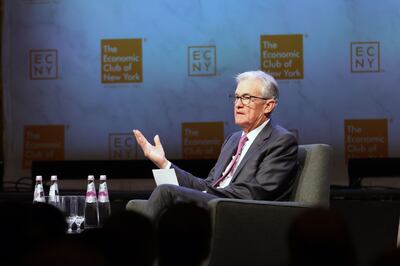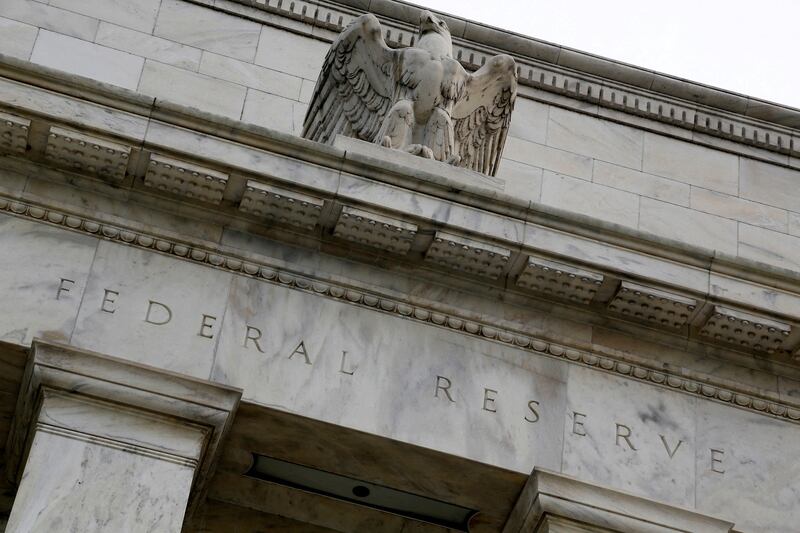Federal Reserve Chairman Jerome Powell has suggested that the US central bank is inclined to hold interest rates steady again at its next meeting while leaving open the possibility of a future increase if policymakers see further signs of resilient economic growth.
The comments effectively affirm market expectations for the Fed to skip a rate increase for a second straight meeting when officials gather on October 31 and November 1.
The Fed chief also said a recent run-up in long-term Treasury yields, if it persists, could lessen the need for further rate increases “at the margin”, echoing his colleagues and underscoring the importance of tightening financial conditions to the rate outlook over the coming months.
“Given the uncertainties and risks, and how far we have come, the committee is proceeding carefully,” Mr Powell said on Thursday at the Economic Club of New York.
“We will make decisions about the extent of additional policy firming and how long policy will remain restrictive based on the totality of the incoming data, the evolving outlook, and the balance of risks.”
Yields on two-year Treasuries declined after Mr Powell spoke, while 10-year yields pared an increase that pushed them near the 5 per cent mark. The dollar fell against a basket of major currencies, and the S&P 500 index of stocks, after numerous twists and turns, fell.
“For November, he has clearly sent a signal of pause,” said Laura Rosner, partner at Macropolicy Perspectives. “He expects the economy to cool down in the fourth quarter, and yields are doing some of the work for them.”
Before beginning his remarks, Mr Powell was briefly escorted out of the room after protesters interrupted the New York event. The demonstrators, who were standing arm in arm, were chanting “end fossil finance” and were forcibly removed from the stage before Mr Powell returned.
Officials left their policy rate unchanged last month in a range of 5.25 per cent to 5.5 per cent and their forecasts showed 12 in 19 officials wanted one more increase this year. Mr Powell was careful not to rule out the possibility of further tightening in his remarks.
“Additional evidence of persistently above-trend growth, or that tightness in the labour market is no longer easing, could put further progress on inflation at risk and could warrant further tightening of monetary policy,” he said.
Speaking during a question-and-answer session with Bloomberg TV, Mr Powell said he thought “the evidence is not that policy is too tight right now”.
Core inflation, excluding volatile food and energy prices, has decelerated to slightly below 4 per cent on an annual basis and just below 3 per cent on a three-month annualised measure.
At the same time, recent economic data showed US retail sales exceeded forecasts and industrial production strengthened in September, while non-farm payroll gains have averaged 266,000 over the past three months, a robust pace.
While three and six-month measures of core inflation are running below 3 per cent, Mr Powell warned short-term measures were often volatile.
“In any case, inflation is still too high, and a few months of good data are only the beginning of what it will take to build confidence that inflation is moving down sustainably toward our goal,” he said.
Mr Powell also said there was evidence the Fed’s rate increases were putting downward pressure on the economy, and said “there may still be meaningful tightening in the pipeline”.
The Fed chief said there were signs the labour market was cooling, although he repeated that a “sustainable” return to 2 per cent inflation would probably “require a period of below-trend growth and some further softening in labour market conditions”.
The speed of the Powell tightening campaign has been the fastest since former chairman Paul Volcker unleashed his attack on inflation in the late 1970s.
An abrupt rise in longer-term Treasury yields since July has prompted some Fed officials, such as vice-chairman Philip Jefferson, to focus more on overall financial conditions as they consider their next move.
Two-year Treasury yields rose to a 17-year high Tuesday while 10-year notes are near their peak for the year.

Mr Powell said the recent surge is mostly due to rising term premiums, detailing several factors that could be causing the increased yield demand from investors, including the central bank’s quantitative tightening programme.
“They’re revising their view about the overall strength of the economy and thinking even longer term it may require higher rates,” Mr Powell said. “There may be a heightened focus on fiscal deficits. QT could be part of it.”
Fed officials have restated their intention to get inflation back to 2 per cent, although minutes of the September meeting now show they are also weighing the risk of too much restraint and sending the economy into a downturn.
Speaking later on Thursday, Chicago Fed president Austan Goolsbee emphasised the need to keep inflation expectations anchored, which the Fed has been able to do so far because of its credibility and commitment to doing “whatever it takes” to tame price pressures, he said.
“When the inflation expectations become unhinged, the job becomes that much harder, because you have to defeat not just the inflation today,” he said.
His counterpart at the Philadelphia Fed, Patrick Harker, repeated his view that the central bank should hold interest rates steady, but that he was keeping an eye on data and that he would not hesitate to support more rate increases if needed.
“A resolute, but patient, stance of monetary policy will allow us to achieve the soft landing that we all wish for our economy,” he said.
Dallas Fed President Lorie Logan said later on Thursday that she was “not yet convinced” that inflation was trending down to the central bank’s 2 per cent target, but added that higher long-term yields were giving officials more time to evaluate economic data.
In response to a question about when the Fed might start cutting interest rates, Ms Logan said she was “not thinking about that right now.”






